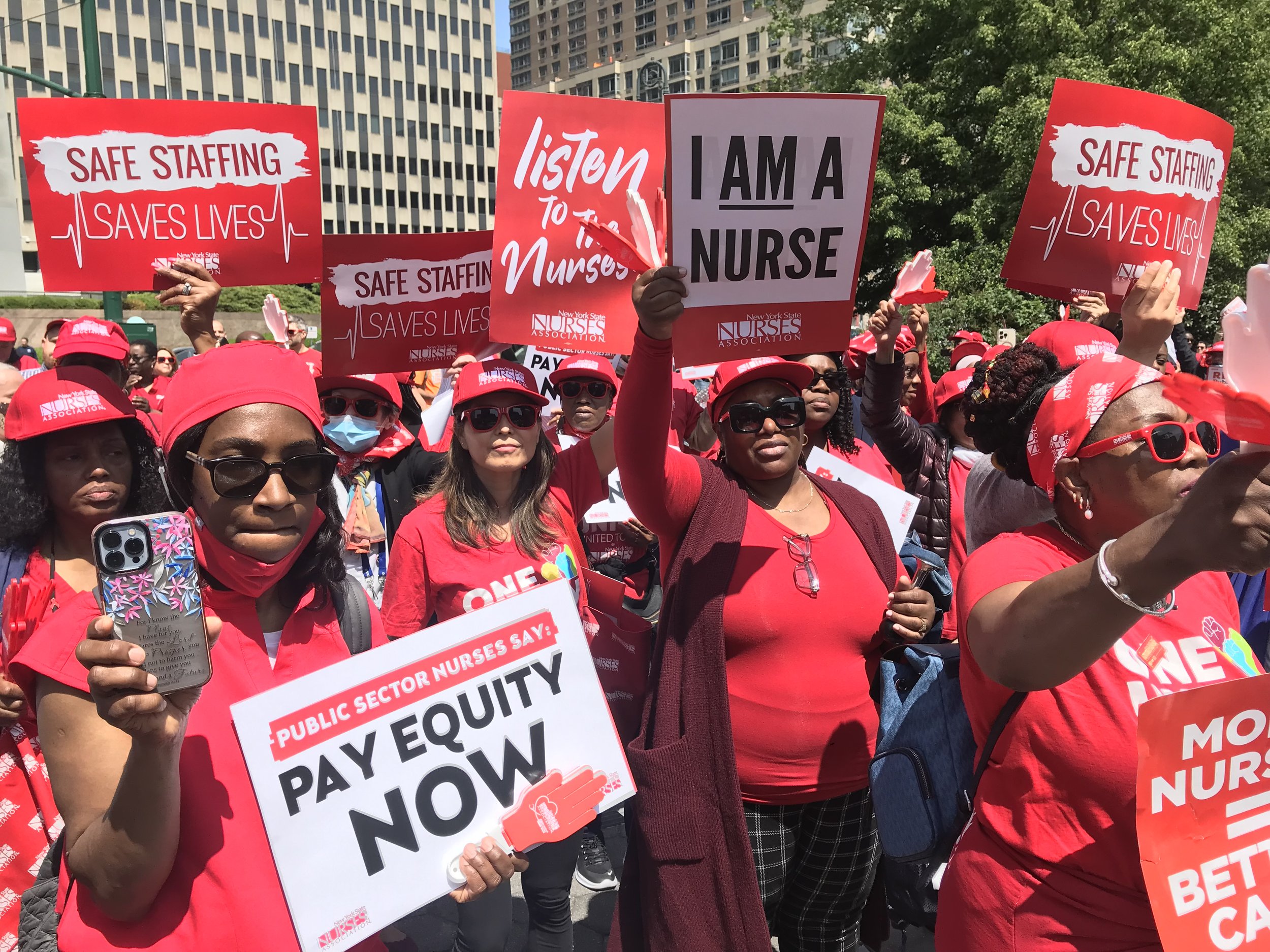NYC H+H Nurses Win Big Raise in Ongoing Fight for Pay Parity
After taking to the streets, NYC public hospital nurses have secured a new 5-and-a-half year deal containing raises of more than $16,000. Photo by Steve Wishnia.
By Steve Wishnia
Nurses at New York City public hospitals and other city-run health facilities have won a contract that will immediately raise their salaries by more than $16,000, the New York State Nurses Association announced July 31.
The 5½-year deal, awarded by an arbitrator several hours before the two sides’ self-imposed deadline of Aug. 1, will give the 8,000 nurses in NYC Health+Hospitals’ 11 hospitals and mayoral agencies a $16,006 raise in its first year and $5,551 more in the second. After further increases of 3%, 3%, and 3.25% in the last three years, the nurses would end up making at least $32,000 a year more, according to NYSNA—the largest salary increase ever for city public-sector nurses.
One of the union’s main goals was “pay parity” with nurses at private hospitals, who on average start out making $20,000 a year more than those in the city system.
“It brings us much closer to the private sector, particularly at safety-net hospitals,” Kristle Simms-Murphy, secretary of the union’s NYC H+H/Mayorals Executive Council, told Work-Bites Aug. 1. “We surpassed our requests, and now we’re able to get more nurses into the public sector, with more competitive salaries.”
“We won’t be a revolving door anymore,” says Sonia Lawrence, president of NYSNA’s NYC H+H/Mayorals Executive Council and a longtime nurse at Lincoln Hospital in the Bronx. The higher salaries will enable the city hospitals to recruit and retain experienced nurses, she explains. Currently, many nurses leave for private hospitals within their first year, as soon as they have enough clinical experience to qualify for jobs there.
“We’ll be able to train nurses better,” Lawrence continues. When she started out 30 years ago, she explains, she had to have six months of orientation before she could practice at patients’ bedsides, and when she did, “I had a resource person I could get help from.”
But during the COVID pandemic, she says, a lot of nurses were pushed into the system without any clinical experience, “tossed in to sink or swim.”
The contract also contains procedures to enforce safe-staffing ratios, such as having one nurse for every patient in intensive-care units, she adds. It also establishes a citywide “float pool” of about 100 nurses, to have on-staff nurses available to fill in where others are absent or positions are vacant, instead of having to hire temporary travel nurses from agencies.
“I give credit to all of our members,” says Alizia McMyers, a Harlem Hospital nurse and vice president of NYSNA’s NYC H+H/Mayorals Executive Council. The union surveyed its members to ask what they wanted, and found that the two most important were pay parity, “to show that they were valued,” and staffing enforcement, for safe care.
When they went into negotiations with that, she added, “we were forceful.”
NYSNA’s contract with NYC H+H expired on March 2. The talks went to mediation last month after the two parties agreed to an escalated schedule of talks. As the Aug. 1 deadline approached, an impasse arbitrator took over. The union and management both presented their arguments and proposals, a NYSNA spokesperson said, and the arbitrator ruled in favor of the union’s—agreeing that the failure to retain nurses was endangering the public-hospital system, and that improving staffing would save the city the expense of hiring temporary nurses, more than $1 billion over the last two years.
That will mean “our patients can get the care they deserve, and they don’t have to be turned away by facilities that won’t accept them for being uninsured or underinsured,” says Simms-Murphy. NYC H+H’s 11 hospitals have to take everybody, she explains, and that includes a lot of immigrants, who often don’t have health insurance.
Under state law, the city’s more than 500,000 undocumented immigrants are not eligible for Medicaid, except for emergency services. The city’s public hospitals’ mission includes caring for patients regardless of their ability to pay.
The NYC H+H hospitals are all considered “safety-net hospitals,” because they serve a large percentage of patients who are on Medicaid or have no insurance. Some private hospitals in the city, such as Kingsbrook Jewish, Maimonides, and Wyckoff in Brooklyn and Richmond University in Staten Island, are also on the list.
Private nonprofit hospitals in New York are required to provide emergency care to all patients and to report “charity care” for uninsured patients, according to NYSNA. In practice, though, private hospitals on the safety-net list are usually in the city’s poorer neighborhoods, and often in financial trouble because Medicaid pays less than private insurance companies do.
The new contract brings NYC H+H nurses up to parity with union nurses at those hospitals, who are represented by NYSNA and 1199SEIU.

